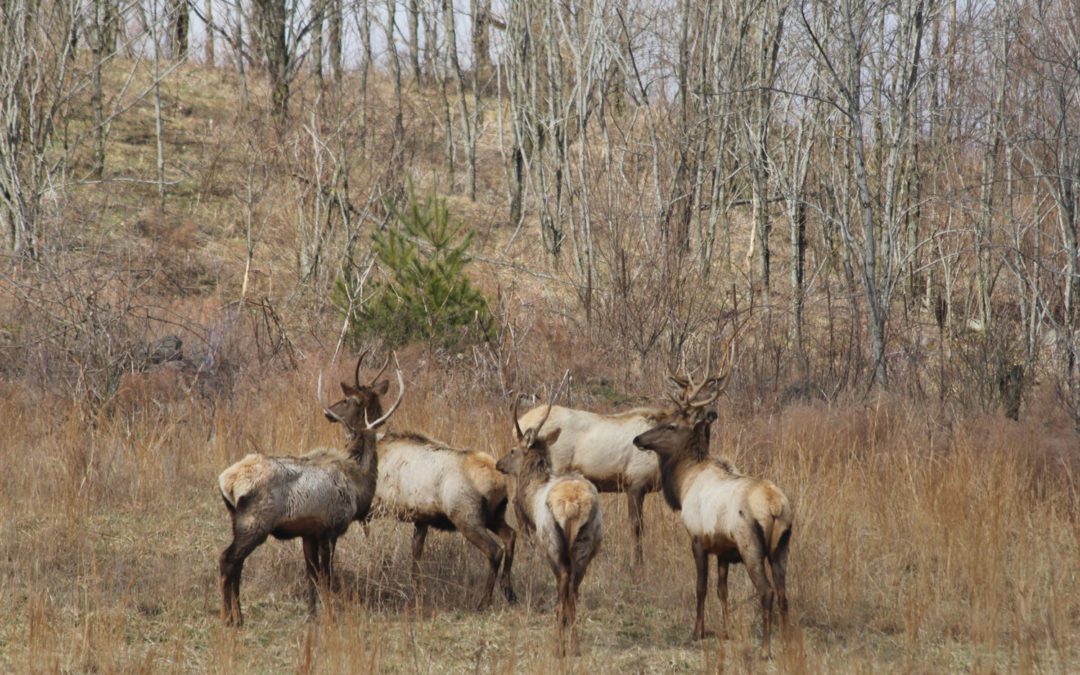In the background, white clouds seemed to rest on the blue ridges of the mountain tops. The sky and the mountains never ended. It was almost heaven. A place where wildlife now dwells in abundance. Where plentiful deer roam and turkeys feed by the pond at midday. A place where herds of elk thrive.
I wasn’t somewhere out west though. I was in Grundy, Virginia, where my ancestors once pushed cattle up from Tennessee into the foothills of southern Appalachia. I was looking at the ridge of Russell county from one side and the mountains that form the state line of West Virginia.
71 elk were brought to Virginia between 2012 and 2014 to begin an elk restoration project. Now, the elk herd stands at about 200. The thousands of hours spent by volunteers with RMEF and the Virginia Department of Game & Inland Fisheries (DGIF) are what has made this project successful. One of those volunteers, Leon Boyd, guided us across this mountain that the elk now claim.
Boyd was born and raised in Grundy. His passionate dedication is the reason Virginia is home to elk again. Totally committed to conservation, Leon is also Vice President of Noah Horn Well Drilling, President of L&D Well Service, Chairman of the Southwestern Virginian Coalfields RMEF, Chairman of Southwest Virginia Sportsmen, and board member for DGIF.

Glassing at every bend of the trail, Boyd was relaying a wealth of knowledge while sharing his zeal for this restoration project.
“There’s one,” said Boyd. The bull elk was hiding in a thicket fifty yards away, so still that I hardly noticed him staring at me. The gold hue from the winter sun was like God’s spotlight on him, and it was magical. This was the first time I’d ever seen an elk east of the Mississippi, and here it was in my home state. Pride washed over me as a native of this place.
I was carefully approaching him, trying to capture photos when I noticed two more bulls to his right. I was startled when two white-tailed deer sprinted from the same patch of brush to my right, gracefully galloping into the valley.
Quietly keeping our distance, we followed the elk around the bend where they met up with two more bulls. The five moved out of sight, and once again we stealthily followed. We briefly lost sight of them until we rounded another curve along the wooded path.
Suddenly a herd of nearly fifty elk stampeded across the trail in front of us. I’ve never seen anything like it. I could do nothing except watch in awe.
“This is why I love this,” said Boyd. I could sense his emotions. “I love seeing people’s faces when they witness this. I love to see their expressions. This is why I do this.”
Increased tourism is a hopeful expectation of the elk restoration in this undeveloped area of southwest Virginia. Three viewing stations that overlook various areas of the valleys have been built by volunteers for visitors to come and enjoy the wildlife. Anything from birds and bees to elk and bear are regularly spotted from these viewing stations.
The region does have a new resort, Southern Gap Outdoor Adventures. Here you’ll find cabins and a campground for tents and R.V.’s. They also have a shower house, ATV rentals, and over 200 miles of ATV trails. There will also be a visitor’s center that should open this year.
Visitors can expect to see elk at the break of dawn while having their coffee, or during lunch at the picnic tables that overlook the valleys. For a county that’s been surviving on the coal industry since the late 19th century, the resort is a welcome breath of fresh air and a harbinger of good things to come.
As for elk hunting, they remain protected in the counties of Wise, Dickinson and Buchanan. However, elk are permitted to be harvested with a deer tag if a hunter encounters one while hunting on unprotected property. In 2015, a deer hunter harvested a young bull elk that came within shooting distance of him on Clinch Mountain WMA.
The Virginia Department of Game & Inland Fisheries (DGIF), Noah Horn Well Drilling, Southwest Virginia Sportsmen, and Rocky Mountain Elk Foundation have made this restoration project a conservation success. But what has allowed it to flourish is the passion, determination, and admiration for a thing and a place so delicate.

